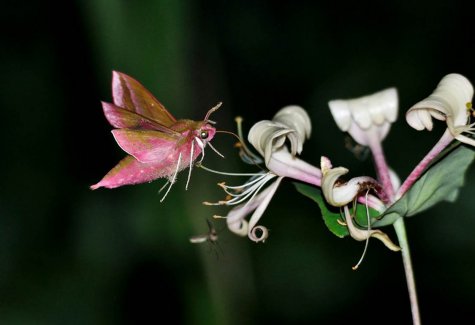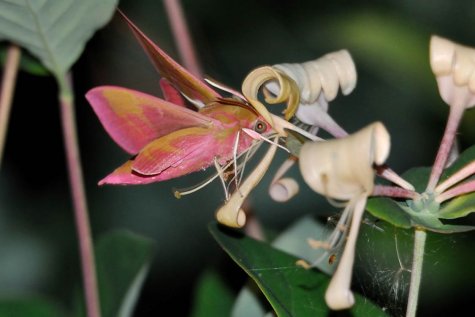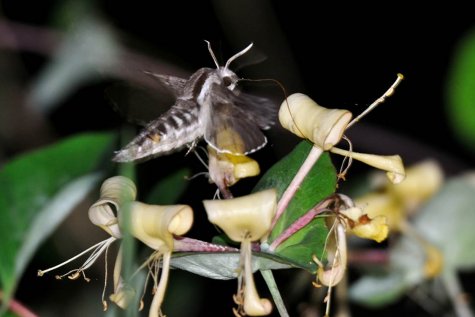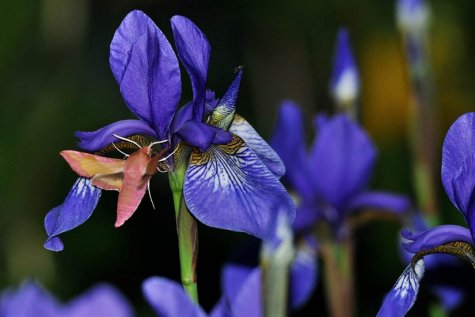Hawk-moths on early summer blooms
Author Rein Kuresoo
Translation: Liis
In the beginning of June the honeysuckle bursts into its white evening gown of blooms. It becomes the most lavish host to the early summer night balls of moths. As evening dusk arrives the honeysuckle spreads its irresistibly scented ball invitations. Earliest of all at sunset the Bedstraw hawk-moths (Hyles gallii) with the banded abdomen come to visit. They have the honour of being the first to press their proboscis into the intoxicating nectar hidden in the flower’s bowl. But excusing themselves with their early rising time the bedstraw hawk-moths leave as suddenly as they arrived. Only then comes the barrage of the late ball lions – first the small elephant hawk-moths, scrambling in a somewhat discourteous manner, but they have at once to accept that they are as cats at a pigeon ball. After the bedstraw hawk-moths have left to comfort themselves among the yellow flags, rhododendrons and weigela flowers the clearly more well-mannered large elephant moths arrive. Among the ball guests some brown pine hawk-moths and a few solitary large and mysterious privet hawk-moths (Sphinx ligustri) can be seen. Some hawk-moth species, such as the aspen hawk-moths (Laothoe) and eyed hawk-moths (Smerinthus ocellatus) refuse the invitation of the honeysuckle, their life as imagos passes in fasting.
Their powerful flight and the nocturnal coolness require much energy from the butterflies (in order to take off into flight in a cool evening, moths at first have to warm their thorax by rapidly vibrating the wings). Because of this, they gladly use the opportunity to fuel up on nectar from the scented flowers and will not be particularly disturbed even by torch lights. The redolent shrub teeming with large moths offers an experience that is not available at any ball. If you turn off the light the hum of the wings of the large butterflies is audible, sending ever new sweetly scented bursts of sensations into the air.
The hawk-moths pollinate flowers that have a long flower tube or spur. Charles Darwin, of whom an important research theme was the insect pollination of plants, in 1862 received from Madagascar a specimen of the orchid species Angraecum sesquipedale, which has a spur with a length of 20-35 centimetres, and was amazed – it was not known which insect might have a long enough proboscis to reach the bottom of the spur of this flower. In his book ”The Pollination of Orchids” that was published in the same year he predicted the existence of such an insect.
Some years later Alfred Russel Wallace published an article in which he supported the hypothesis of Darwin, noting that the hawk-moth Xantophan (Macrosila) morganii living on the African continent had an instrument with the required length. Wallace writes: „It may confidently be predicted that a similar hawk-moth species also exists in Madagascar and naturalists visiting this island might search for it there with the same confidence that the astronomers searched for the planet Neptunus – they will surely be as successful in their search”.
A hawk-moth with a proboscis of suitable length was discovered in Madagascar in 1903 and was named Xanthopan morganii praedicta (praedicta means predicted). True, later it was found that it is not a separate sub-species – the hawk-moth species living in Madagascar does not differ in any respect from its relatives on the African mainland.
Elephant moth sucking nectar from a perfoliate honeysuckle flower. For the long proboscis of the butterfly to reach the bottom of the equally long flower tube the elephant moth must stick its head into the flower. At the same time its underparts rub against the pistil and stamens.
Pine hawk-moth on honeysuckle
Small elephant moth busy on the flowers of Siberian iris. Honeysuckle was not touched – evidently the proboscis is too short. So truly a Small Elephant Moth after all












